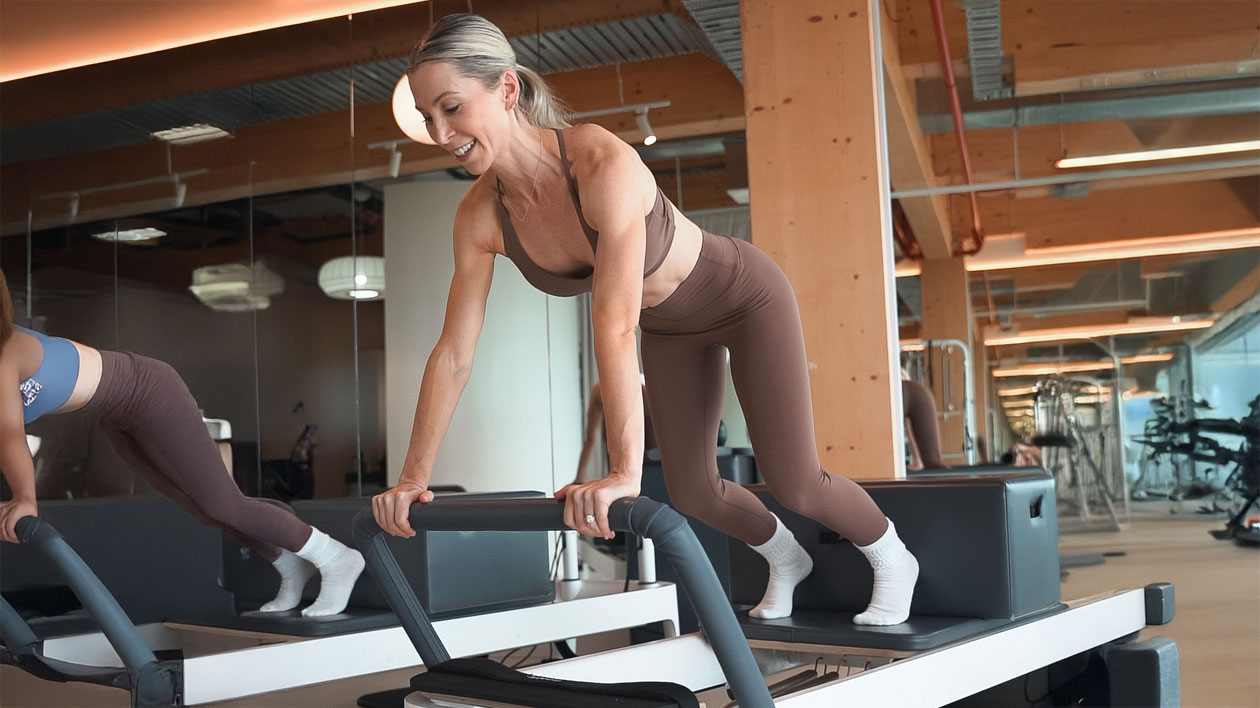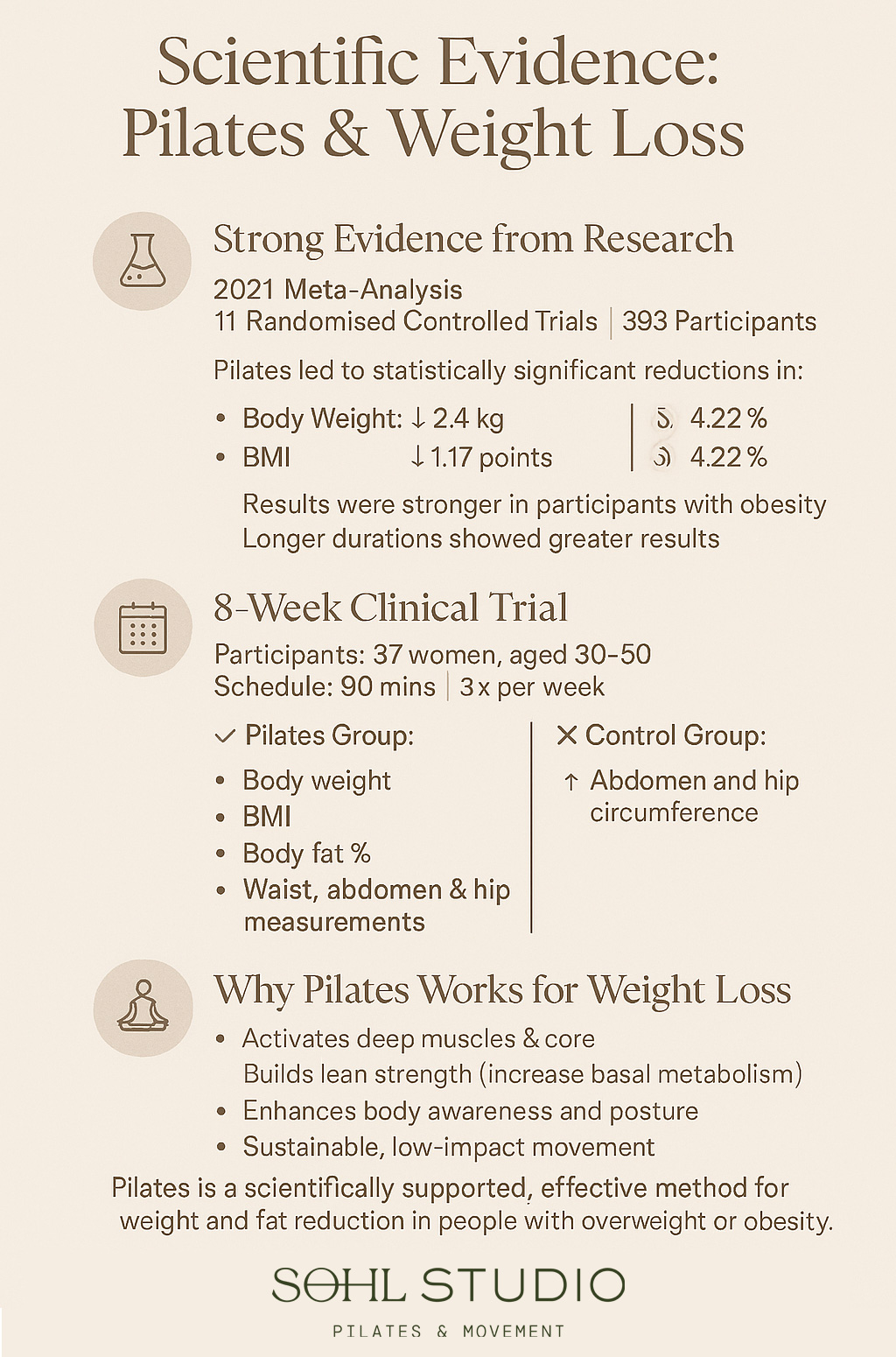
Pilates is good for losing weight by helping reduce body fat, BMI, and overall weight, especially in overweight individuals. While it burns fewer calories than high-intensity cardio, Pilates builds muscle and boosts metabolism, which supports long-term weight loss and body composition improvements.
Scientific Evidence Supporting Pilates for Weight Loss
Recent research provides substantial evidence for Pilates as a weight loss intervention amongst other health benefits. A comprehensive 2021 meta-analysis of 11 randomised controlled trials with 393 participants found that Pilates significantly reduces body weight (mean difference of -2.40), BMI (mean difference of -1.17), and body fat percentage (mean difference of -4.22) in adults with overweight or obesity [1]. This meta-analysis noted that weight loss effects were more pronounced in participants with obesity, and results improved with longer intervention durations.
Another study involving 37 women aged 30-50 demonstrated that after 8 weeks of Pilates practice (90 minutes, 3 times weekly), participants experienced significant decreases in weight, BMI, fat percentage, and circumference measurements of the waist, abdomen, and hips. Importantly, the control group that did not participate in Pilates showed increases in abdomen and hip circumference during the same period [2].
Medical research further confirms that Pilates effectively reduces body weight and body fat percentage in overweight and obese participants, establishing it as a viable option for weight management.
How Pilates Facilitates Weight Loss
Muscle Development and Metabolic Enhancement
Pilates builds lean muscle mass throughout the body, particularly focusing on core strength. This muscle development is crucial for weight management because muscle tissue burns more calories than fat tissue, even at rest. By increasing muscle mass, Pilates helps raise your basal metabolic rate (BMR), enabling you to burn more calories throughout the day, not just during exercise.
Engagement of Multiple Muscle Groups
Unlike some isolated exercises, Pilates engages multiple muscle groups simultaneously during each movement. This comprehensive muscle engagement increases calorie burn during workouts and continues afterward as the body repairs and rebuilds muscle tissue. The controlled, precise movements characteristic of Pilates require continuous muscle activation, contributing to energy expenditure.
Improved Body Composition
Rather than focusing solely on weight loss, Pilates promotes favorable changes in body composition by decreasing fat mass while maintaining or increasing lean body mass. This body recomposition approach often results in a more toned physique, even if the scale doesn’t show dramatic changes.
Calorie Burning in Pilates
While Pilates isn’t typically categorised as a high-calorie-burning exercise, it does contribute to calorie expenditure:
- A typical 60-minute Pilates session burns approximately 175-375 calories, depending on intensity and the participant’s current weight. More specifically, Pilates burns between 4-7.5 calories per minute, resulting in approximately 120-225 calories for a 30-minute session.
- Research indicates that intermediate and advanced Pilates workouts can meet requirements for weight loss when performed with sufficient frequency and duration. For optimal weight loss results, experts recommend practicing Pilates at least four days weekly for 45-60 minutes per session.
Pilates Compared to Other Exercise Forms
When comparing Pilates to other exercise modalities for weight loss:
Pilates generally doesn’t burn as many calories as high-intensity cardio exercises like running or cycling. However, it offers complementary benefits that support a comprehensive weight loss approach, including better endurance. While cardio exercises excel at immediate calorie burn, Pilates contributes to long-term metabolic enhancement through muscle development.
Unlike purely cardio activities, Pilates incorporates strength, stability, and flexibility training in one workout. This makes it particularly valuable for individuals who find high-impact exercises challenging or those looking for a balanced fitness approach that addresses multiple aspects of physical health.
Optimising Pilates for Weight Loss
To maximise weight loss results from Pilates:
Frequency and Duration
For weight management goals, aim for Pilates sessions at least 4 days weekly, with each session lasting 45-60 minutes. Consistency is crucial—regular practice yields more significant results than occasional intense sessions.
Intensity Considerations
The calorie-burning potential of Pilates largely depends on intensity. More challenging versions, particularly Reformer Pilates (using specialised equipment), can elevate heart rate and engage more muscle groups than basic mat exercises. As your fitness improves, progressively increase difficulty by incorporating more advanced movements or additional resistance.
Complementary Exercise Approach
For optimal weight loss results, experts recommend combining Pilates with other forms of exercise. A balanced weekly routine might include 2-4 Pilates sessions, 2-3 cardio workouts, and 1-2 strength training sessions. This combination leverages the unique benefits of each exercise type while addressing all aspects of fitness.
Can Pilates reduce belly fat?
Pilates can help reduce belly fat as part of an overall weight loss strategy by strengthening and toning the core muscles, improving posture, and increasing lean muscle mass, which boosts metabolism. While it doesn’t directly target belly fat (as spot reduction isn’t possible), Pilates contributes to overall fat loss when combined with a healthy diet and other forms of exercise, such as cardio. It also promotes mindfulness and stress reduction, which can help manage behaviors linked to abdominal fat storage. For best results, practice Pilates regularly (3-5 times per week), incorporate cardio workouts, and maintain a balanced diet.
Ready to give Pilates a go? Reach out to the friendly team SOHL Studio and get started on your journey to a better you.

